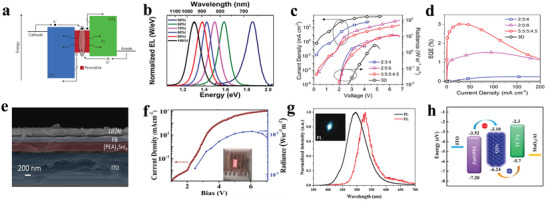Figure 12.

a) Schematic representation of typical electroluminescent device structure. Reproduced with permission.[ 221 ] Copyright 2016, Springer Nature. b) Normalized EL spectra of ITO/PEDOT:PSS/CH3NH3Sn(Br1‐ xIx)3/F8/Ca/Ag LED. Reproduced with permission.[ 206 ] Copyright 2016, American Chemical Society. c) Dependence of the current density and radiance on the driving voltage for (PEAI)x(CsI)y(SnI2)z. d) EQE values versus current density for (PEAI)x(CsI)y(SnI2)z. For the (PEAI)3.5(CsI)5(SnI2)4.5 MQW‐based LED, a maximum EQE of 3% is achieved. Reproduced with permission.[ 188 ] Copyright 2017, American Chemical Society. e) Cross‐sectional picture of the ITO/PEDOT:PSS/(PEA)2SnI4/F8/LiF/Al device. Reproduced with permission.[ 129 ] Copyright 2017, American Chemical Society. f) Current density versus voltage (J−V) and radiance versus voltage characteristics for glass/ITO/PEDOT:PSS/Cs3Sb2I9 thin film/TPBi/LiF/Al. Reproduced with permission.[ 156 ] Copyright 2019, American Chemical Society. g) PL spectrum of the CsCuBr2 micro‐crosses on the Si substrate and EL spectrum of the LED at 2.8 V. Inset: a PL photograph of the CsCuBr2 micro‐crosses. Reproduced with permission.[ 198 ] Copyright 2019, Royal Society of Chemistry. h) Simplified energy levels of each layer of the heterostructure in LED based on Cs3Sb2Br9 nanocrystals. Reproduced with permission.[ 195 ] Copyright 2019, American Chemical Society.
